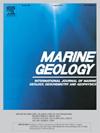红海北部的Mabahiss深海:来自高分辨率深海测绘和分析的新见解
IF 2.2
3区 地球科学
Q2 GEOSCIENCES, MULTIDISCIPLINARY
引用次数: 0
摘要
红海北部大部分被蒸发岩覆盖,覆盖着它的基底结构和岩石圈的相关岩性。地下室只暴露在几个被称为“深”的地方。马巴希斯深海是红海北部最大的深海。它拥有一个巨大的海底火山,Mabahiss Mons,位于Zabargad断裂带的北部。我们使用新的高分辨率测深数据、ROV图像和玄武岩样本分析来绘制Mabahiss Deep的形态图,以了解该地区的火山构造环境,并研究其地质演化,为一个年轻的海洋盆地提供见解,该盆地可能代表全球其他超慢扩张脊。结果表明,Mabahiss深是一个深2360 m的轴向谷,与北西-东南方向的红海正断层平行。Mabahiss Mons有一个2公里长的山顶火山口,下盘含有柱状玄武岩,火山锥和枕状熔岩,以及表明全新世活动的广泛熔岩流。玄武岩海底火山口在这样的环境中是罕见的,但与相当大的熔岩流和高熔体供应相一致,这是由于岩浆集中和红海热通量升高,尽管扩张速度缓慢。岩石样品分析显示为morb型成分,没有大陆地壳的相互作用。综上所述,Mabahiss深是一个典型的洋中脊段,证实了在红海北部这部分海域发生了海洋扩张过程。本文章由计算机程序翻译,如有差异,请以英文原文为准。

Mabahiss Deep in the Northern Red Sea: New insights from high-resolution bathymetric mapping and analysis
The northern Red Sea is largely floored by evaporites, covering its basement structure and associated lithology of the lithosphere. The basement is exposed at only a few locations, called “Deeps”. Mabahiss Deep is the largest deep in the northern Red Sea. It hosts a large submarine volcano, Mabahiss Mons, and lies north of the Zabargad Fracture Zone. We use new high-resolution bathymetric data, ROV images, and basalt sample analysis to map the morphology of the Mabahiss Deep to understand the volcano-tectonic setting of this area and study its geologic evolution, providing insights into a young ocean basin that is potentially representative of other ultra-slow spreading ridges worldwide. Our results show that Mabahiss Deep is a 2360 m deep axial valley bordered by NW-SE Red Sea axis-parallel normal faults. The Mabahiss Mons has a ∼2 km summit caldera containing columnar basalts at its footwall, volcanic cones with pillow lavas, and extensive lava flows indicating Holocene activity. The basaltic submarine caldera is rare in such settings but is consistent with considerable lava flows and high melt supply due to magma focusing and elevated heat flux in the Red Sea, in spite of the slow spreading rates. The rock samples analysis shows MORB-type composition without any interaction of continental crust. Together our results show that Mabahiss Deep is a typical mid-oceanic ridge segment, confirming that oceanic spreading processes are occurring in this part of the northern Red Sea.
求助全文
通过发布文献求助,成功后即可免费获取论文全文。
去求助
来源期刊

Marine Geology
地学-地球科学综合
CiteScore
6.10
自引率
6.90%
发文量
175
审稿时长
21.9 weeks
期刊介绍:
Marine Geology is the premier international journal on marine geological processes in the broadest sense. We seek papers that are comprehensive, interdisciplinary and synthetic that will be lasting contributions to the field. Although most papers are based on regional studies, they must demonstrate new findings of international significance. We accept papers on subjects as diverse as seafloor hydrothermal systems, beach dynamics, early diagenesis, microbiological studies in sediments, palaeoclimate studies and geophysical studies of the seabed. We encourage papers that address emerging new fields, for example the influence of anthropogenic processes on coastal/marine geology and coastal/marine geoarchaeology. We insist that the papers are concerned with the marine realm and that they deal with geology: with rocks, sediments, and physical and chemical processes affecting them. Papers should address scientific hypotheses: highly descriptive data compilations or papers that deal only with marine management and risk assessment should be submitted to other journals. Papers on laboratory or modelling studies must demonstrate direct relevance to marine processes or deposits. The primary criteria for acceptance of papers is that the science is of high quality, novel, significant, and of broad international interest.
 求助内容:
求助内容: 应助结果提醒方式:
应助结果提醒方式:


